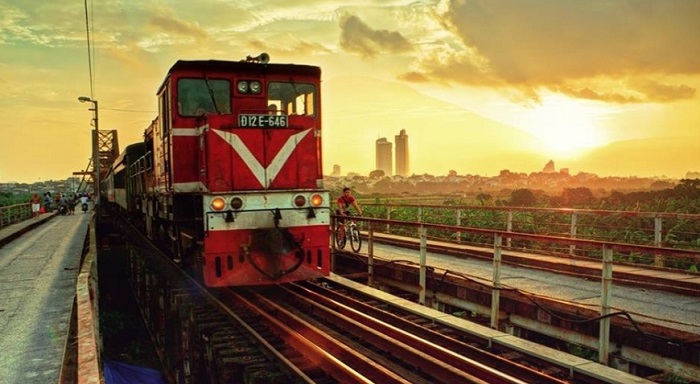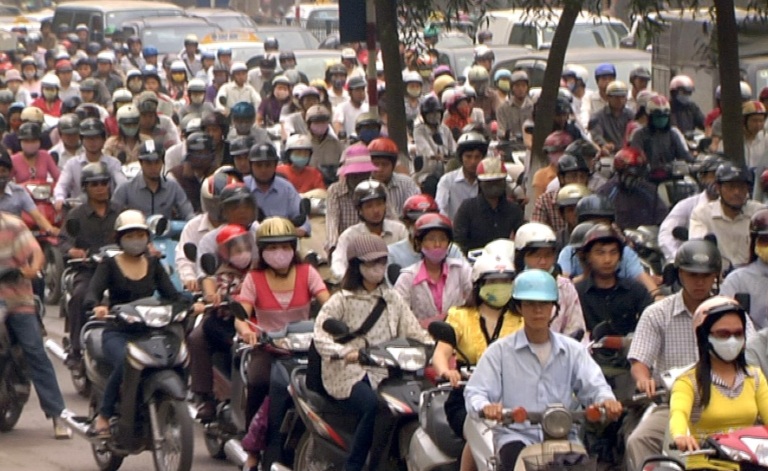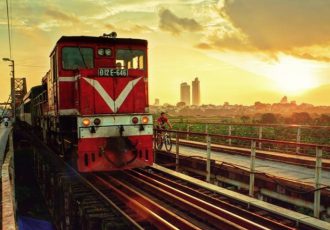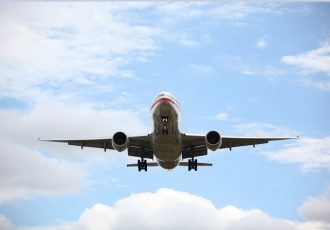Transport and Infrastructure
For the past twenty years, transportation in Vietnam has been developing rapidly as the Vietnamese economy modernizes at an impressive pace. It is therefore no exaggeration to say that the highly dynamic, even somewhat bustling, image of vehicles of all kinds in Vietnam is the most faithful reflection of the liveliness of this country and its people in moving beyond their past and looking toward the future.

Infrastructure
In fact, Vietnam is now connected to almost every continent thanks to air travel, which is becoming increasingly competitive in terms of both quality and price. Within Vietnam, road infrastructure, air transport, and airports are also developing dramatically. Road networks, while inheriting the old roads that already cover the entire country, are expanding with new, increasingly modern roads. Alongside the long-standing national roads, numerous international-standard highways have been built. Domestic flights also regularly serve the three regions of the country. Railways connect not only Hanoi with the northern mountains, but also almost all provinces on the north-south axis, all the way to Ho Chi Minh City in the south. There are not only road and air transport lines that are multiplying and modernizing, the agencies that participate in them are also increasingly numerous, diversified, and therefore increasingly competitive: planes of all categories, carriages from very high comfort levels to those of average quality, buses and cars of all kinds, taxis from very varied agencies that crisscross everywhere, even the smallest alleys, motorcycle taxis that are found at all intersections, public transport in all major cities, cruise ships of all sizes and categories in tourist ports. However, there are certain fears that concern, for example, the level of security due to a high density of vehicles on the roads. Motorcycles in particular are the most vulnerable to the risk of incidents. Otherwise, in general, traveling with other means of transport is quite safe. Additionally, while transportation options are varied and numerous, information is lacking, especially for foreign tourists who are unfamiliar with local life and have difficulty navigating a foreign and exotic place. Therefore, a minimum level of knowledge is necessary for a tourist traveling alone. It would also be best to have a basic vocabulary in Vietnamese. In this article, Horizon Vietnam Travel attempts to provide you with useful information on the various travel options and the use of appropriate means of transportation, also highlighting the advantages and disadvantages of each type.
Getting around within Vietnamese cities or between a city and its suburbs
If you're in Hanoi or Ho Chi Minh City, don't worry! Public transportation networks cover everything. Just read the signs carefully to avoid making a mistake. There are often single fares for all routes (between 7,000 and 10,000). Taxis are also another great option. In big cities like Hai Phong, Hanoi, and Ho Chi Minh City, there are many agencies. For a foreign visitor, even a Vietnamese who doesn't know the way, there's certainly a risk of being ripped off. So, to avoid this, the best way is to use prestigious agencies like Mai Linh or Taxi Group, which are used to transporting foreign tourists, or to entrust the call to a receptionist at your hotel, who can also help you get an idea of the distance and price. Generally, the fare is 11 to 13 thousand dong/km for the first ten kilometers traveled (or 0.54 euros). Motorcycle taxis are also highly recommended, as they are everywhere and the prices are very reasonable, averaging 10,000 dong (or 0.4 euros) per km. However, drivers don't speak very good English, except for those in the city center. Rental agencies are quite numerous in Hanoi's Old Quarter or downtown Ho Chi Minh City. The price varies between 6 and 20 dollars per day depending on the type of motorcycle. Fuel is not included.
Moving from one city to another in Vietnam
Bus
From North to South or from South to North, there are many bus agencies. You only have to go to the bus stations located in the four corners of each city to see for yourself the very different bus categories. For a long journey, you will be recommended to choose comfortable buses, and this is not at all difficult. Prices are quite different between a hard seat and a soft seat or between a soft seat and a soft sleeper. But in any case, the fares are now displayed for everyone to see. Mai Linh is a good brand. On the other hand, the bus agencies that usually serve tourist centers from North to South are: An Phu, Sinh Café… their buses are often air-conditioned, clean, and secure. There are several daily departures.
It's worth noting that Mai Linh is the most reputable airline in Vietnam. Their network is extensive, the service is good, and the prices are very reasonable. You can choose to buy tickets for the entire route or for smaller trips, and purchase items as you go along your route.

This type of transport is practical and above all very economical. To give you an idea, here are some examples of prices:
Hanoi – Ho Chi Minh City: 600,000 dongs/or: 25 euros
Ho Chi Minh City – Da Lat: 150,000 dongs/or: 6.25 euros
Ho Chi Minh City – Hue: 400,000 dongs/or: 16.6 euros
Hue– Hoi An: 60,000 dongs/or 2 euros
Hanoi – Quang Binh: 200,000 dongs/or 8.3 euros
Hue – Hanoi: 200,000 dongs/or 8.3 euros
* Prices are for information only and subject to change
To purchase/reserve tickets, you can go in person or book by phone, mail, or email. The agency you contact must be located in the same city as your destination. Reservations must be made 24 hours in advance. Some companies offer to pick you up from your home before departure and take you to the bus. This convenient service is free!
Train:
While traveling by train in Vietnam still takes quite a while due to the narrowness of the rails, it can be noted that Vietnam Railways, with the active participation of private companies, has made a great effort to improve the level of comfort to adapt to the growing needs of foreign travelers. There are already cabins with soft berths and air conditioning. Tourist carriages are now available on both lines, namely Hanoi-Lao Cai and Hanoi – Hue – Ho Chi Minh City, with numerous stops in each province. A train journey from Ho Chi Minh to Ha Noi takes about 29 hours. You can sleep in a berth at night and during the day, admire the landscape of Vietnam from South to North.
Additional services include: soft or hard bench seat; soft/hard bunk bed; air conditioning. VIP carriages have 4 beds, sometimes 2 beds, closed by a door; popular compartments have either 4 or 6 berths; this type of compartment is not closed.

Food can be purchased on the train, but it's often not of high quality. You'll need to plan to carry something to eat for the entire journey. Good to know: SE-registered trains are faster than TN-registered trains.
The price for information purposes only: 810,000 Dongs/33 euros (soft armchair with air conditioning); 1,300,000 Dongs/54.3 euros (soft bunk bed with air conditioning).
For a Hanoi-Lao Cai and vice versa journey, it takes approximately 8 to 9 hours. Departures are between 7:00 PM and 9:30 PM. These trains arrive very early in the morning at the terminus, between 4:30 AM and 7:00 AM. Tickets can be purchased online or directly at the ticket offices, which are numerous at Hanoi and Lao Cai train stations. However, for foreign tourists, it is best to book tickets at least 20 days before departure. As ticket shortages are not uncommon, travelers are advised to book them before leaving for Vietnam through their travel agencies. Reservations often depend on management fees ranging from US$1,000 to US$3,000 per ticket and availability.
Motorcycle:
Motorbikes remain the most common and popular means of transportation in Vietnam. Each family has between 3 and 4 motorbikes, and they have a wide variety of uses: personal transportation in most cases, taxis, freight transport, and street vendors.
For foreign tourists, motorbikes are often the preferred choice for getting around town or even visiting distant regions. To meet this growing demand, rental agencies are increasingly numerous in the tourist districts of each city, such as Hanoi, Hue, Ho Chi Minh City, etc.
However, as motorcycles are most at risk of collision with high vehicle density on the roads, you will be advised to take precautions, especially regarding speed and signs.
The plane
Domestic flights are operated by Vietnam Airlines , Jetstar Airlines, and Qantas Airlines. The services are of good quality and the price is reasonable. While Vietnam Airlines' prices are not the best, they are recognized as the most reliable and serious. The airlines now serve all three regions of the country, including the North-Central and South. However, the most frequent routes are Hanoi-Ho Chi Minh City and vice versa, Hanoi-Hue or Hanoi-Da Nang and vice versa, and Hai Phong-Ho Chi Minh City and vice versa. Overall, the safety level of air travel in Vietnam is high. However, flight schedules may sometimes be subject to change without notice. Unexpected cancellations may occur.






